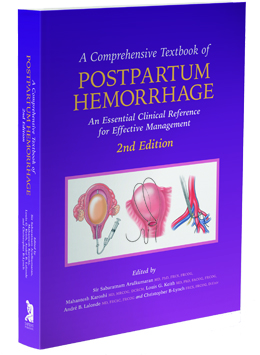A Comprehensive Textbook of Postpartum Hemorrhage 2nd Edition
An essential clinical reference for Effective Management
Edited by Sir Sabaratnam Arulkumaran, Mahantesh Karoshi, Louis G. Keith, Andre B. Lalonde and Christopher B-Lynch
Prelims, Title pages, Contents, List of contributors
Section 1 – Essential 'Must Read' Chapters
Chapter 1:
Managing the Ten Most Common Life-Threatening Scenarios Associated with Postpartum Hemorrhage
Chapter 2:
Uterovaginal Blood Supply
Chapter 3:
Management of Exsanguinating Patients in Trauma
Chapter 4:
Transfusion Management of Obstetric Hemorrhage
Chapter 5:
Early Use of Fibrinogen in the Treatment of Postpartum Hemorrhage
Chapter 6:
New Approaches to Transfusion Therapy for Postpartum Hemorrhage
Section 2 – Introduction
Chapter 7:
Is Postpartum Hemorrhage a Legacy of our Evolutionary Past?
Chapter 8:
Postpartum Hemorrhage Today
Chapter 9:
Blood Loss
Chapter 10:
Assessing and Replenishing Lost Volume
Chapter 11:
Pitfalls in Assessing Blood Loss and Decision to Transfer
Chapter 12:
Doppler Evaluation of Hemodynamic Changes in Uterine Blood Flow
Chapter 13:
Pathophysiology of Postpartum Hemorrhage and Third Stage of Labor
Chapter 14:
Active Management of the Third Stage of Labor
Chapter 15:
Active Management of the Third Stage of Labor
Section 3 – Demographic Considerations
Chapter 16:
Definitions and Classifications
Chapter 17:
Definitions, Vital Statistics and Risk Factors
Chapter 18:
Maternal Morbidity and Near Misses
Chapter 19:
Problems in Determining Accurate Rates of Postpartum Hemorrhage
Chapter 20:
Maternal Deaths from Major ObstetricHemorrhage in the UK
Chapter 21:
Declining Mortality Rate from Postpartum Hemorrhage in Japan and Factors Influencing the Changes
Section 4 – Causation
Chapter 22:
Hemodynamic Changes in the Uterus and its Blood Vessels in Pregnancy
Chapter 23:
Obstetric Trauma
Chapter 24:
Bleeding from the Lower Genital Tract
Chapter 25:
Acquired and Congenital Hemostatic Disorders in Pregnancy and the Puerperium
Chapter 26:
Vascular Malformations as a Cause of Postpartum Hemorrhage
Section 5 – Placental Abnormalities
Chapter 27:
Placental Abnormalities
Chapter 28:
Management of Placenta Accreta
Chapter 29:
The Management of Placenta Accreta at Queen’s Hospital, Romford, UK
Chapter 30:
Mifepristone and Misoprostol for the Management of Placenta Accreta
Chapter 31:
One-Step Conservative Surgery for Abnormal Invasive Placenta
Section 6 – Misoprostol
Chapter 32:
Misoprostol
Chapter 33:
Misoprostol in Practice
Chapter 34:
Overview of Misoprostol Studies in Postpartum Hemorrhage
Chapter 35:
Sublingual Misoprostol for the Treatment of Postpartum Hemorrhage
Section 7 – Hospital Preparation
Chapter 36:
Labor Ward Drills
Chapter 37:
Preparedness for Postpartum Hemorrhage
Chapter 38:
Non-pneumatic Anti-Shock Garments
Chapter 39:
The Mechanisms of Action of the Non-Pneumatic Anti-Shock Garment
Chapter 40:
Building Hospital Systems for the Care of Women with Major Obstetric Hemorrhage
Chapter 41:
State Mandated Training in Obstetric Hemorrhage
Section 8 – Therapy for Atonic Bleeding
Chapter 42:
Management of Postpartum Hemorrhage at the Community Level at Home
Chapter 43:
Standard Medical Therapy for Postpartum Hemorrhage
Chapter 44:
Carbetocin for the Prevention of Postpartum Hemorrhage
Chapter 45:
Intraluminal Pressure Readings whilst Achieving a Positive – Tamponade Test – in the Management of Postpartum Hemorrhage
Chapter 46:
Internal Uterine Tamponade
Chapter 47:
Balloon Internal Uterine Tamponade: Experience with 39 Patients from a Single Institution
Chapter 48:
Using the Uterine-Specific Bakri Balloon in the Management of Postpartum Hemorrhage
Chapter 49:
Embolization and Balloon Catheter Placement
Chapter 50:
The Use of Recombinant Factor VIIa
Section 9 – Therapy for Non-atonic Bleeding
Chapter 51:
Conservative Surgical Management
Chapter 52:
Internal Iliac (Hypogastric) Artery Ligation
Chapter 53:
Initial Interventions to Combat Hemorrhage during Cesarean Section and Internal Iliac Artery Ligation
Chapter 54:
The Pelvic Pressure Pack and the Uterovaginal Balloon System
Chapter 55:
Peripartum Hysterectomy
Chapter 56:
The Management of Secondary Postpartum Hemorrhage
Chapter 57:
Use of Fibrin Sealants in Obstetric Hemorrhage
Chapter 58:
Topical Hemostatic Agents in Obstetric Hemorrhage
Section 10 – Consequences of Postpartum Hemorrhage
Chapter 59:
The Normal and Pathologic Postpartum Uterus
Chapter 60:
Severe Acute Maternal Morbidity and Postpartum Hemorrhage
Chapter 61:
Learning to Treat Postpartum Hemorrhage
Chapter 62:
Intensive Care Management after Major Postpartum Hemorrhage
Chapter 63:
Litigation: an International Perspective*
Section 11 – How Health Professionals Deal with Postpartum Hemorrhage
Chapter 64:
Management of Postpartum Hemorrhage in Low Resource Settings
Chapter 65:
The Obstetrician Confronts Postpartum Hemorrhage
Chapter 66:
The Midwife Confronts Postpartum Hemorrhage
Chapter 67:
A Community-Based Continuum of Care Model for the Prevention and Treatment of Postpartum Hemorrhage in Low Resource Settings
Chapter 68:
Human Behavior in Medical Emergencies
Section 12 – Special Circumstances
Chapter 69:
Out-of-Hospital Deliveries
Chapter 70:
Intraoperative Autologous Blood Transfusion
Chapter 71:
Treating Hemorrhage from Secondary Abdominal Pregnancy: Then and Now
Chapter 72:
Jehovah’s Witnesses and Those Who Refuse Blood Transfusion
Chapter 73:
MamaNatalie a Birthing Simulator for Realistic Training to Control Postpartum Hemorrhage
Appendix
Index

